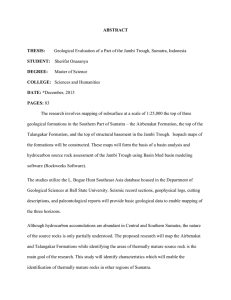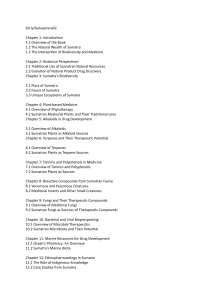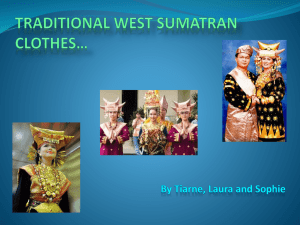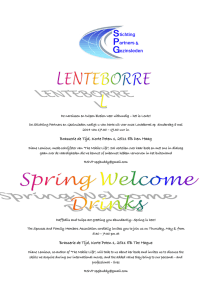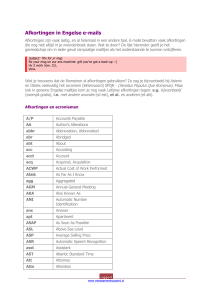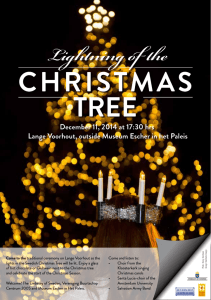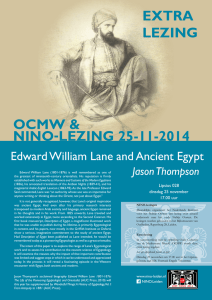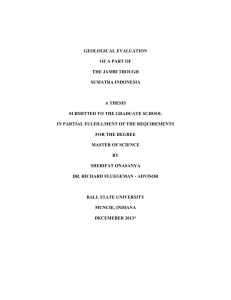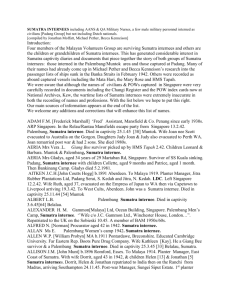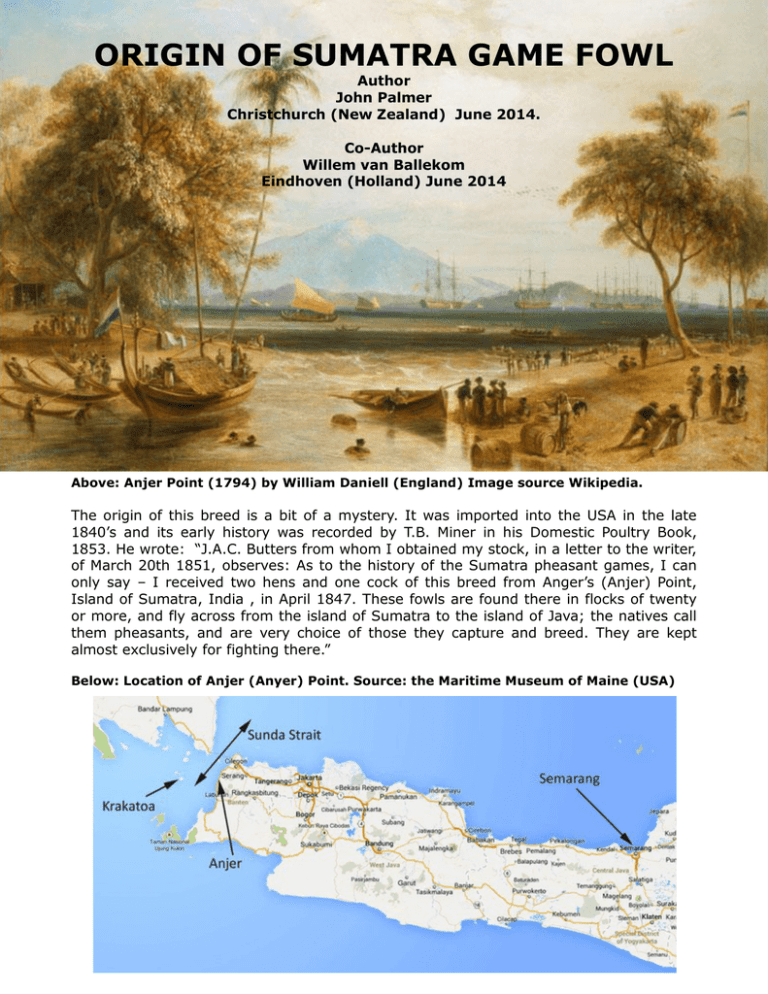
ORIGIN OF SUMATRA GAME FOWL
Author
John Palmer
Christchurch (New Zealand) June 2014.
Co-Author
Willem van Ballekom
Eindhoven (Holland) June 2014
Above: Anjer Point (1794) by William Daniell (England) Image source Wikipedia.
The origin of this breed is a bit of a mystery. It was imported into the USA in the late
1840’s and its early history was recorded by T.B. Miner in his Domestic Poultry Book,
1853. He wrote: “J.A.C. Butters from whom I obtained my stock, in a letter to the writer,
of March 20th 1851, observes: As to the history of the Sumatra pheasant games, I can
only say – I received two hens and one cock of this breed from Anger’s (Anjer) Point,
Island of Sumatra, India , in April 1847. These fowls are found there in flocks of twenty
or more, and fly across from the island of Sumatra to the island of Java; the natives call
them pheasants, and are very choice of those they capture and breed. They are kept
almost exclusively for fighting there.”
Below: Location of Anjer (Anyer) Point. Source: the Maritime Museum of Maine (USA)
Note: Anyer (also Anjer) is a town in Banten, formerly West Java, Indonesia.
There were few subsequent imports and Europe only received birds from the USA late in
the 19th century.
Right: Sumatras
imported into
Germany (1895)
Drawing by Jean
Bungartz
(Germany)
It was usual in the 18th and 19th centuries
for sailing vessels to carry livestock as a
living food source on their voyage and to
collect these at any port of call where
they were available. Anjer was an
important trading stop in the Sunda
Straits between Sumatra and Java before
the eruption on Krakatoa in 1883.
According to a September 1850 report in
the Straits Times, more vessels called at
Anjer than in the capital port of Batavia.
The reason is illustrated by a report (see
below) in the 1886 British Admiralty
China Sea Directory, vol. 1, covering
Western Malaya and Sumatra, which
states; “In the south-east monsoon,
vessels both outward and homeward
bound, often call at Anjer for supplies.
Buffaloes, poultry, vegetables, fruit,
hogs, sheep, turtle, and water are to be
procured. Native craft from Anjer, with
supplies, will be met in Sunda strait, and
even as far northward as the Brothers.”
Left: Straits Times 3rd September 1850,
page 7.
Right: Sketches, Civil and Military of
the Island of Java (1812)
by Sir Samuel Auchmuty (England)
During my time as a civil servant in
Malaya in the 1950’s and 60’s, I was
unable to visit Sumatra due to
Indonesia’s hostility to the formation
of Malaysia following independence in
1957. But I am reasonably certain
that the breed did not exist in
Malaya.
Later
visits
to
Java,
particularly the large open bird
markets in Jakarta and Surabaya
came up with nothing. Though for
anyone following my example I would
recommend looking for the poultry
hybrids with the green jungle fowl
(ayam bekisar) which are often
spectacular in both colour and crow.
Below: An example of an Ayam
Bekisar. Image source Lewang
Serama Farms (Indonesia)
Dr. Carlos Finsterbusch in his comprehensive treatise on Cock-fighting written in the
1920’s, devoted considerable effort in corresponding with Dutch authorities in Sumatra to
find evidence of this breed with negative results.
Vrijburg in Het Indische kippenboek, 3rd edition 1939, says of the Sumatra:
“Ajam Jallah of groenhoen, door de Inlanders zoo genoemd naar zijn schitterend zwart
groenglanzend pluimage. Zij leven in troepen van tien tot twintig in het wild op Sumatra. Ze
worden getemd en voor vechtdoeleinden aangehouden.
Het lichaam is slank, doch goed gespierd. De wilde kunnen zeer goed vliegen. Door hun langen
laaggedragen staart doen ze in hun vlucht aan fazanten denken. Door de Inlanders worden ze zoo
ook genoemd. De kop is klein. Kam en kinlellen zeer zwak aanwezig. Door den rozekam wordt het
tot de abnormale rassen gerekend. Oogen donkerbruin tot donkerrood. Bek weinig gebogen,
middelmatig lang, groenachtig tot zwart van kleur. De hals is lang en wordt eenigszins naar voren
gebogen gedragen. De borst is vol en rond. De rug sterk afloopend naar den staart. De romp
gestrekt. Het zadel is lang en sterk bevederd. De staart wordt laag bijna horizontaal gedragen en
is versierd met zeer lange en breede sikkelveeren. De dijbeenen zijn goed bevederd. Het loopbeen
is onbevederd, leiklurig zwart. Heeft alleeen als vechthoen waarde. Het gewicht de hanen
bedraagt 2.25-2.75 kg. De hennen halen 1.5 kg. De hennen leggen kleine witte lichtbruine eitjes”.
A rough translation of the above is; “Ajam Jallah or Green Chicken, this name is given by
the natives due to its green glossy plumage. They live in groups of ten to twenty in the
wild in Sumatra. They are tamed for cockfighting purposes. The body is slender but
muscular. The wild ones are very good flyers. Due to their long low carried tail in flight
they look like pheasants. The natives call them pheasants. The head is small. Comb and
wattles are present but very small. Due to their rosecombs they are classified as an
abnormal breed. Eyes are dark-brown to dark-red. Beak slightly curved. Medium sized
long, greenish to blackish. The neck long and slightly carried forwards. Breast is full and
round. The body stretched . The saddle is long and well feathered. The tail is carried low
almost horizontally and decorated with long wide sickle-feathers. The thighs are well
feathered. The shanks are not feathered, slate-black. It is only used as a gamecock.
Their weight, the cocks
2.25 - 2.75 Kg. The hens
reach 1.5 Kg. The hens
lay
small
whitelightbrown eggs”.
He goes on to reprint the
U.S standards for the
breed. But he probably
never actually saw a wild
Sumatra game.
A scientist at the Bogor
Agricultural College Dr.
Panji Artomoro, mentions
a black rooster which he
calls Ayam Selasih. This
is probably the nearest
we will get to the birds
exported 160 years ago.
Right and next page:
Ayam Selasih cock.
Photos by Dr. Panji
Artomoro.
Left: Modern day Sumatra
Game cock.
Photo/breeder Willem
van Ballekom.
So in conclusion I would
suggest
that
Sumatra
game were an accidental
import taken on in Anjer
by a trading vessel and
purchased on the vessels
arrival in Boston by an
enthusiastic
poultry
fancier.
They
just
happened to be a black
selection
of
a
local
farmer’s poultry which
could have been unique at
the time, and never
widely distributed.
Right: Sumatra showing
that typical green glossy
plumage.
Photo/breeder Willem
van Ballekom.
Copyright ©2014
All rights reserved by the
Aviculture-Europe Foundation.
This is a publication by the
online magazine
www.aviculture-europe.nl
English edition
ISSN: 2352-2445
You are not allowed to copy,
distribute, send or publish these
texts or photos
without our prior permission in
writing.

